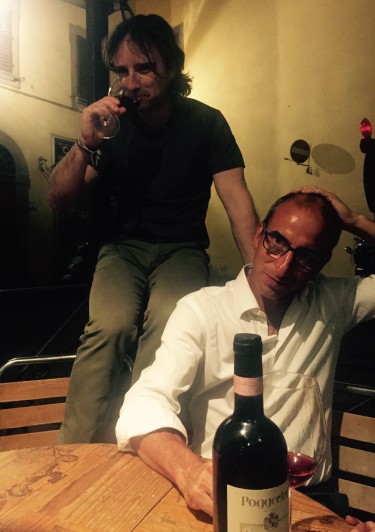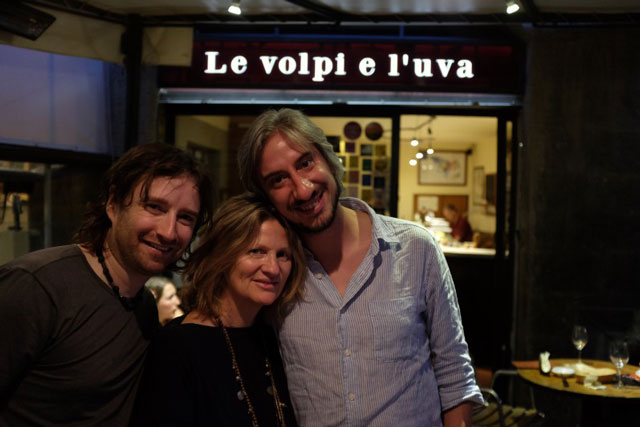Behind the bar on any given day or evening, are a pair of clever wine lovers, better known as foxes—Le volpi e l’uva (The Fox and the Grape) is tucked on a back side street in Florence, across the Arno river not far from the Ponte Vecchio.
It’s is my “uscio e bottega” (home away from home) wine bar. It’s off the beaten path, and that’s one of the reasons why I like it.
The marble bar curves through the small space with stools that peer over the counter at chest level. It frames the blackboard with daily wines by the glass, and covers the handy work going on behind the scenes. Various bruschette, hand-cut prosciutto, crostini, savory salads, French and Italian cheese plates, keep the belly occupied while sipping carefully selected wines from lesser known producers in Italy and beyond.
Conversations are hot topics, expressed freely and broken down to a manageable common denominator, as Florentines usually have philosophical opinions that pair well with the subtle nuances of what’s in the glass. This must be why The World of Fine Wine just voted them Best Short Wine List Europe-2015—it’s casual, yet serious business on a local and international level.
Le volpi e l’uva is anything but ordinary, call it rustic Florentine, and idealistic. Emilio Monechi, Ciro Beligni and Riccardo Comparini have different styles and yet they work side by side. If you are lucky to get all three of them behind the counter at the same time, especially if you are alone at the bar, it’s quite engaging.
Ciro, the youngest fox with a quick Florentine wit and good palate, understands what these young wine makers are passionate about. Once in a while, he offers an opportunity for a winemaker’s tasting. It’s very informal, and fits the description of Le Volpi’s “down to earth” approach. It translates as an intelligent, sensorial game, to come sit and taste and discuss something ethereal that is hard to put into words.
Piero Lanza is a gentle man and he doesn’t waste any time beating around the bush when we meet: he wants to talk about his wine—organic, with a biodynamic approach. I’m all ears. And it’s quite easy to listen to the history as he describes his noble land in Chianti Classico. The land was originally part of the Prince Ginori Conti family, of which he is a direct descendant. “My grandfather took it over in 1940 and died at 72. My father took it over in 1999.” says Piero. Even though he was studying agronomy in Florence, he wasn’t that interested in making his own wine at 17, but by the time he was 19, he was ready. He was tired of studying and his father was tired of working. He went back to the countryside every weekend to touch base with what he was learning. At that point, he realized he should get to work with the 12 hectares he had. It would take some time to transform the old vineyard and that it was plenty. If he had more, he couldn’t work it himself, nor could he travel. And he likes to travel a lot.
Piero realized that he had a lot to learn and hired an enologist that became like a second father to him. “I needed to develop my sensitivity to observe.” His father had given him responsibility of the vineyards straightaway, so he had to learn quickly.
“The enologist taught me that if you want to give your wine something more, something deeper, it begins in the vineyard.”
His education was traditional and hyper-chemical but his travels took him to France, Australia, Chile, Spain and the US which left a mark on his work:
“I wanted to open my mind,everyone has different ways to make wine and it encouraged me to do things differently. France taught me that wine is made in the vineyards. It’s all about taking care of the soil. Australia makes their wines in the cellar. When the grapes ripen too quickly, you lose complexity. They have to adjust it in the cellar.”
Piero was skeptical about organics at first as the school was against BIO. He soon realized that if he wanted to be working in the vineyards everyday, he didn’t want to be surrounded by poison. He thought, what is not good for me, can’t be good for the plants either. Little by little, he starting leaving certain chemicals out, until there was nothing left. He began using copper and sulfur, natural substances that are not systemic, and nothing else and never looked back.
Things didn’t get worse, they got better:
“If for some reason I have to stop being organic, I will sell the vineyard. I see the strength of the plants to resist the ups and downs of climate variations. With chemicals they become weak and dependent. Not to mention, without interference the fruit expresses itself more honestly. The minerality, the graphite characteristics of my land, the acidity, the long tanins are more pure. You either like that style or you don’t.”
Intense climate changes have taken place since 1997 that have changed a winemaker’s approach. Piero says,
“You can’t just be organic in practice, you have to look at the seasons and the vintage. We are working with different ground from year to year. We have to have beginner’s mind. We have to work deep and be very sensitive to many things in a short time at the right time. The moment of harvest is fundamental. I go in the vineyard to taste and I have to decide what is the right time. It’s challenging, it’s usually a window of 30 days, but we must harvest in 9-10. The goal is to get healthy grapes, uva sana. The best quality will be ready in a week, but if I know it’s going to rain, I’ll pick tomorrow. Sometimes I have to blend the more acidic fruit, with more ripe. Sometimes you don’t know how it’s going to work out.”
To slow down the ripening, he slows down the green harvest at verasion in July. “I wait until the grape is completely dark. I want the skin to build tannins slowly. There is a motive to our madness”, he says. He doesn’t trim his vines like a lot of vitners, he prefers to “intracciare,” to wind the vines around the support wires, so as not to stress the plants, because cutting them actually forces them to grow, which can add stress. This allows the canopy to diminish and the plant gets more of what it needs.
The difference between organic and biodynamic is a bit esoteric. Organic could be just eliminating chemical fertilizers and sprays, and choosing alternative methods such as non-systemic copper and sulfur. But, biodynamic is all about energy. Its focus is 80% on the soil. A common practice is to use ground quartz that has been planted under the ground in a cow horn. It treats soil fertility by harvesting the cosmic forces in the ground. The farmers make various concoctions of cow dung and spray it on the plants. Sounds a bit new age, like following the phases of the moon (which in fact our Farmer’s Almanac has been a proponent of since the days of early America), when in fact, it’s an old world technique created by Austrian Rudolf Steiner in the early 1900’s.

Poggerino is not a certified Biodynamic wine. Piero explains:
“I like to be ahead of the curve. We practically talk to the vines and try to listen to what they need, then give it. We start with the smallest thing so they don’t turn into big things. It’s good earth, good white stones, good minerality, good exposition east west. I’d like to think it’s particular.”
I talked to other wine makers on the crowded terrace of small tables, packed to the gills. I wanted their take, not only on the wine but on the subject of BIO.
Alessandro Tofanari, an organic Vernaccia di San Gimignano producer said,
“Organic producers don’t need someone to say, don’t do this or that. We know. I knew 40 years ago that I wanted to go BIO. ”
Valentino Ciarla, enologist, is enthusiastic about the trend, which he says will be the norm soon, or else “the others will be left in the dust.” He says he still can’t tell the difference in the glass during a blind tasting. I think Piero would think differently, as would Stefano Amerighi, a certified Biodynamic producer of Syrah who was also present.
“It’s about energy. Biodynamic practices energize the soil. It’s all about soil fertility, plant growth and livestock as ecologically interrelated tasks.”
Most people don’t understand that this practice has a deeper root, emphasizing spiritual and mystical perspectives. Which is to say, it takes viticulture to a whole different level.
Bernardo Conticelli, wine expert and Italian ambassador of Champagne adds,
“Luckily today there is a trend for wineries in Tuscany to move more and more into organic and even biodynamic farming. Definitely small, young talented wineries are very familiar with this process but we can notice also larger estates getting involved into. If a wine is a great wine and it is produced in an organic or biodynamic way, it’s the best combination ever. But the most important thing is that the wine must be a good wine. Nowadays in Tuscany organic and biodynamic farming as well as the discovery of unknown indigenous local grape varieties are the major trends wine professionals need to focus on.”
We may speak about a wine tasting clean as opposed to dirty, an element you pick up when the barrels are not well looked after. It’s relative. But here, we are talking about an absolute—something beyond the norm.
We need to develop our sensitivity to the energetics of what’s in the glass that brings the inherent, natural characteristics of the wine alive. Not just the balance, the body, the structure of the wine, but the philosophy of the wine.
This may or may not be tasted in a blind tasting. Just ask philosopher wine maker Paolo Marchionni. But can your sense perceptions perceive a slightly higher octave to the taste or the bouquet? Is it more alive? Depending on your level of sensitivity, you can feel how what you eat and drink affect you.
The world of wine is complex at best. Knowing what you are doing is fundamental. That’s why not all organic wines are created equal. Previously, there was a prejudice against them. Serious wine drinkers wouldn’t drink them nor would well respected vitners put organic on the label. This has finally changed. These wines are standing up for themselves and deserving respect.
Wine making at its root starts in the vineyard by farmers who are willing to get their hands dirty and deal with the unknown. Not just unpredictable weather, but changing patterns of weather. It’s honest, risky work. It’s also the work of the artisan or alchemist, turning base grapes into something not only drinkable but extraordinary. An elemental beverage to contemplate as it pleases the palate and wakes up the senses, encourages and enhances conversation with food and friends.
~
~ Join Peggy on a culinary adventure in Tuscany. ~
~
Author: Peggy Markel
Editor: Katarina Tavčar
Photo: Author’s own












Read 0 comments and reply